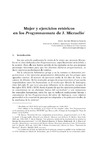Identificador persistente para citar o vincular este elemento:
https://accedacris.ulpgc.es/jspui/handle/10553/73374
| Campo DC | Valor | idioma |
|---|---|---|
| dc.contributor.author | Moreno García, Jesús Alexis | - |
| dc.date.accessioned | 2020-06-18T12:35:56Z | - |
| dc.date.available | 2020-06-18T12:35:56Z | - |
| dc.date.issued | 2019 | - |
| dc.identifier.issn | 0870-0133 | - |
| dc.identifier.other | Scopus | - |
| dc.identifier.uri | https://accedacris.ulpgc.es/handle/10553/73374 | - |
| dc.description.abstract | This work analyses how the female figure is described in the exercises of the Progymnasmata Aphthoniana in usum scholarum et studiosorum eloquentiae by Johannes Micraelius, particularly those in the fable and narrative parts. Our analysis reveals that the presence of women in Micraelius’ examples is remarkable and, besides, that women are always depicted positively rather than considered a punishment for mankind. It may be concluded, therefore, that men and women share the same vices and virtues, these not being exclusive of one gender or the other. In fact, Micraelius draws up a balance between vices and virtues; he opposes destructive and alienating love to castitas, here understood either as abstinence from sex, fidelity to one’s spouse or confluence of interests and life. Likewise, Micraelius opposes superbia (the most outstanding vice and cause of destruction, as it reveals the desire to resemble the gods) to pietas, that is, to man’s submission to God, which brings peace and harmony. | - |
| dc.language | spa | - |
| dc.relation.ispartof | Euphrosyne | - |
| dc.source | Euphrosyne [ISSN 0870-0133], n. 47, p. 367-379 | - |
| dc.subject | 620205 Retórica | - |
| dc.subject.other | Progymnasmata | - |
| dc.subject.other | Rhetorics | - |
| dc.subject.other | Female virtues and vices | - |
| dc.subject.other | Micraelius | - |
| dc.title | Mujer y ejercicios retóricos en los Progymnasmata de J. Micraelio | - |
| dc.type | info:eu-repo/semantics/article | - |
| dc.type | Article | - |
| dc.identifier.doi | 10.1484/J.EUPHR.5.125307 | - |
| dc.identifier.scopus | 85131672645 | - |
| dc.contributor.orcid | NO DATA | - |
| dc.contributor.authorscopusid | 57734796600 | - |
| dc.description.lastpage | 380 | - |
| dc.description.firstpage | 367 | - |
| dc.relation.volume | 47 | - |
| dc.investigacion | Artes y Humanidades | - |
| dc.type2 | Artículo | - |
| dc.utils.revision | Sí | - |
| dc.date.coverdate | Enero 2019 | - |
| dc.identifier.ulpgc | Sí | - |
| dc.contributor.buulpgc | BU-HUM | - |
| dc.description.sjr | 0,101 | - |
| dc.description.sjrq | Q3 | - |
| dc.description.ahci | AHCI | - |
| dc.description.erihplus | ERIH PLUS | - |
| item.grantfulltext | open | - |
| item.fulltext | Con texto completo | - |
| crisitem.author.dept | GIR IATEXT: Filología Clásica "Juan de Iriarte" | - |
| crisitem.author.dept | IU de Análisis y Aplicaciones Textuales | - |
| crisitem.author.dept | Departamento de Filología Hispánica, Clásica y de Estudios Árabes y Orientales | - |
| crisitem.author.orcid | 0000-0002-3792-8887 | - |
| crisitem.author.parentorg | IU de Análisis y Aplicaciones Textuales | - |
| crisitem.author.fullName | Moreno García, Jesús Alexis | - |
| Colección: | Artículos | |
Citas SCOPUSTM
1
actualizado el 08-jun-2025
Visitas
163
actualizado el 15-mar-2025
Descargas
143
actualizado el 15-mar-2025
Google ScholarTM
Verifica
Altmetric
Comparte
Exporta metadatos
Los elementos en ULPGC accedaCRIS están protegidos por derechos de autor con todos los derechos reservados, a menos que se indique lo contrario.
